Kelly Krumrie’s figuring
2020 Roundup
Figuring is a monthly column that puzzles over (to figure) and gives shape to (a figure) writing, art, and environments that integrate or concern mathematics and the sciences.
Kelly Krumrie’s figuring
2020 Roundup
Figuring is a monthly column that puzzles over (to figure) and gives shape to (a figure) writing, art, and environments that integrate or concern mathematics and the sciences.
I’ve been working on this column for over a year now, and it’s becoming increasingly difficult to write—because of the difficulty of the year and because the content is so close to my dissertation work, which is both critical (on math and literature) and creative (on measurement and desire). I’m in an information spiral that’s contracting and expanding, like a fast and horrible slide, or like crawling up one while slowly slipping down. Or stuck somewhere in between. Strange navigation here, and many bibliographies.
For December, then, I thought I’d do a brief year end roundup of art and writing I encountered in 2020 (or reencountered, and not necessarily from 2020). I’ve selected things in line with the theme of this column—figuring, to figure out, to take shape—and with that, works that lean a little math / sciencey. Many of these were recommended by advisors and friends I’m lucky to know. The works below have gotten me out of a few jams in my 2020 thinking and feeling, and they’ve brought (and continue to bring) a lovely, good-puzzled kind of joy. I hope you’ll find some of that too.
In no particular order:
video: “The Arctic” by Wenting Zhu
- Recommendation: muted or with your own music.
song: “MATH” by QUIÑ on Galactica (Fantasy Soul, 2016)
novel: The Baudelaire Fractal by Lisa Robertson (Coach House Books, 2020)
- I wrote a bit about the shape of this novel in “On Fractals, Part 1” and “On Fractals, Part 2.”
images: Lisa Robertson’s Instagram (@office_for_soft_architecture) when she posts pictures of stone slabs and tools, e.g.:
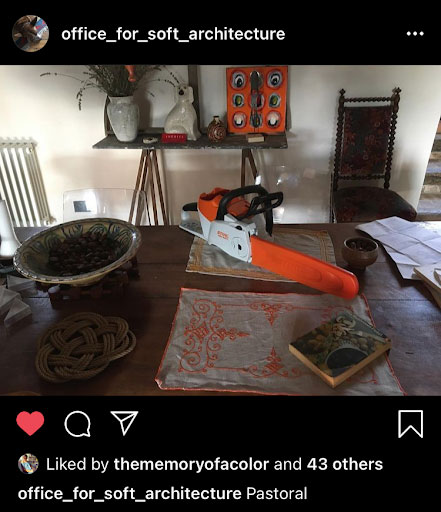

novel: Pamela: A Novel by Pamela Lu (Atelos, 1998)
- This spring, I re-read Pamela for maybe the fourth time or so since I first read it in 2007.
Nothing horrible had befallen me; nothing even remotely urgent had happened or was about to happen around me, except that I was suddenly flooded with the distinct sensation of being overlapped—as if all my thoughts, actions, feelings, preoccupations, and regrets were being compressed into one another at a rate of seven hundred miles per hour in preparation for the approach of a new, mysterious replacement. The transcendence took the form of a vertical ratio, and I, as the lower half of an undefined term, ducked beneath the dividing line that rushed forth to meet me.
article: “Mathematics Black Life” by Katherine McKittrick (The Black Scholar, 2014)
nonfiction: The Mushroom at the End of the World: On the Possibility of Life in Capitalist Ruins by Anna Lowenhaupt Tsing (Princeton University Press, 2015)
film: Routine Pleasures by Jean-Pierre Gorin (1986)
- Documentary about a group of men who are very into model trains, clipboards, and time-keeping alongside reflections on paintings by Manny Farber.
album: Render Another Ugly Method by Mothers (Anti-, 2018)
- Also their song “Copper Mines” from When You Walk A Long Distance You Are Tired (Grand Jury, 2016).
short fiction: Lake Like a Mirror by Ho Sok Fong, translated by Natascha Bruce (Two Lines Press, 2020)
- Not math/sciencey, but figuring out surely, and it was one of my favorite 2020 releases, so I can’t resist. Here’s the title story in Granta.
poetry: Daybreak by William Fuller (Flood Editions, 2020)
- In SPAM zine, Joe Luna writes to Fuller on Daybreak, “This, I think, is how I’ve come to think about a poetics in tune with the most abstract processes of life-determination in the world we live through, that is, because of its tonality, is thus able to produce a beautiful dissonance: that knowledge is produced despite, throughout, and within the very processes that determine its capture and evaluation as merely one appendage of financialized homo economicus. New life spills out of your poems as a function of the accumulated intensity of thoughtful pressing into the language to describe it. It really does work like that, I think, somehow the audacity of making new things appear can be registered as audacity because the prospect of an encounter (or a ‘bowl’) is held out with such baffling precision, whilst the idea itself is always brighter for being half-obscured.”
art: “15 Paintings for the Plantationocene” by Torkwase Dyson (currently on exhibition at the New Orleans Museum of Art)
poem: “To the Reader” by Jena Osman
article: “Orientation in a Big World: On the Necessity of Horizonless Perspectives” by Patricia Reed (e-flux, 2019)
The activity of navigation presupposes the existence of a navigable thing.
novel: Switch Wish by Willy Smart (Meekling Press, 2020)
- I gushed a bit about this one here.
workshop: Restor(y)ation: Orca Poesis, an eco-writing workshop by Miranda Mellis in collaboration with Creature Conserve and the Endangered Species Coalition.
essays: “Notes Toward a Virtual Poetics: On Solaris, Assemblage, and Blackness” (Part 1 and Part 2) by Madison McCartha (Action Books Blog, 2020)
images: This tumblr of diagrams, etc.
film: Red Desert by Michelangelo Antonioni (1964)
- Come for sweeping shots of industry, stay for devastating industrial sound.
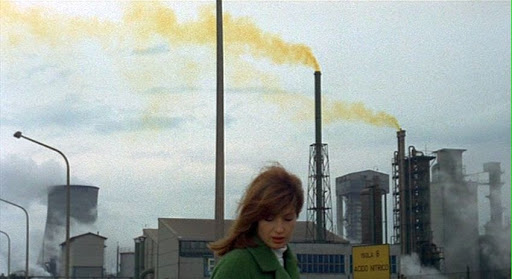
(http://www.filmsufi.com/2010/09/red-desert-michelangelo-antonioni-1964.html)
poetry: The Invention of Glass by Emmanuel Hocquard, translated by Cole Swensen and Rod Smith (Canarium Books, 2012)
- I love and am jealous of Hocquard’s multi-level citational structure at the end of this series of poems.
These
experiments are not aspects
but causes. A series of
unleashed causes: the sound
of leaves in the wind or of the wind
in the leaves. Table of causes.
Which can also mean:
story: “A History of a Noise” by Canisia Lubrin (The Puritan, 2020)
nonfiction: Mathematics as Sign: Writing, Imagining, Counting by Brian Rotman (Stanford University Press, 2000)
- On what it means to do mathematics, especially math as mark-making.
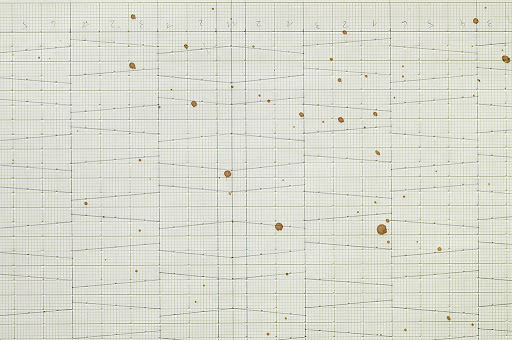
(https://art.daimler.com/en/artwork/konstruktionen-new-york-hanne-darboven-new-york-196667-2/)
essay: “Hanne Darboven” by Miriam Schoofs (Flash Art, 2014)
I only use numbers because it is a way of writing without describing … It has nothing to do with mathematics. Nothing! I choose numbers because they are so constant, confined and artificial. Numbers are probably the only real discovery of mankind. A number of something (two chairs, or whatever) is something else.
art: One Long Black Sentence by Renee Gladman (Image Text Ithaca, 2020)
- I wrote about this new collection of drawings, Fred Moten’s “anindex” at the book’s end, and the relationship between these and geometry and the idea of mathematical proof here.
poetry: The Presentable Art of Reading Absence by Jay Wright (Dalkey Archive, 2008)
Imagine now
the quantum superposition of desire
and a body at rest,
moving with magnetic force
aslant of every desire.
These things we do not record.
art: Community drawing of Sol LeWitt’s Wall Drawing 797 at Georgia Art Space in Denver the weeks leading up to the 2020 U.S. presidential election. (Photo from when I finished my section; full image in the Georgia link.)
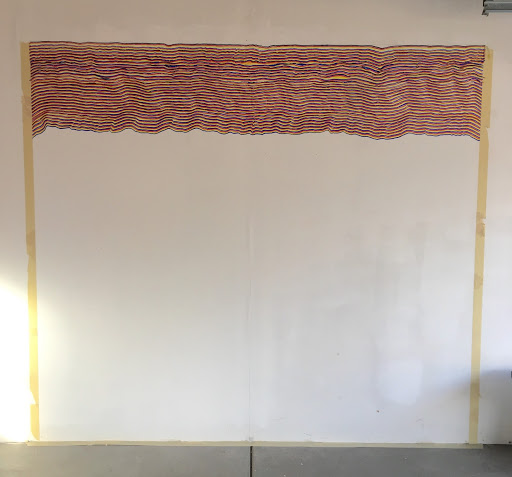
essay: “The Circle With a Hole in the Middle” by Fred Moten (on Sam Gilliam) (Pace Gallery, 2020)
He makes work I can’t get next to and can’t get out of, and though I know I’m supposed to be writing something that you can get something out of, I want you to know that if you don’t get anything out of it, it’s not your fault. It’s my fault, though it’s all Gilliam’s fault—his fault being more of a maelstrom, an irresistible whirlpool, whorl’s absolute intra-action of depth and surface. If you don’t try to get out of it, if you don’t try to get anything out of it, you can be drawn in, too. You can hear when you’re supposed to see and see what you’re not supposed to.
poetry: The Crystal Text by Clark Coolidge (Sun & Moon Press, 1995)
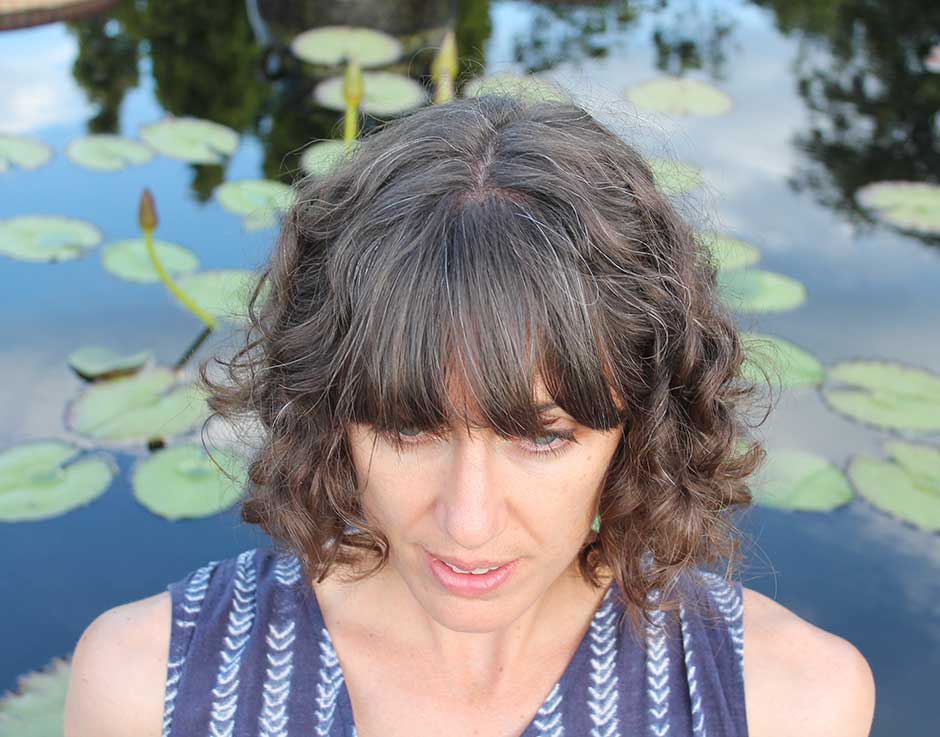
About the Author
Kelly Krumrie‘s prose, poetry, and reviews are forthcoming from or appear in Entropy, La Vague, Black Warrior Review, Full Stop, and elsewhere. She is a PhD candidate in Creative Writing at the University of Denver where she serves as the prose editor for Denver Quarterly.